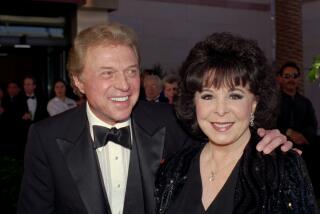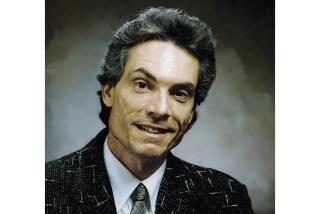An Appreciation: Andy Williams defined the generational divide of the ‘60s
Depending on your age and race, Andy Williams’ 1961 rendition of “Moon River” was either a transcendent embodiment of timeless beauty, or one of the more conservative, white-bread recordings of its time. Either your Christmas sparkled brighter because of his annual TV special, or it ruined an otherwise relaxing night. You loved or hated his taste in sweaters.
The crooner and show host — who died on Tuesday at the age of 84 — embodied a generational divide that came to shape the 1960s. His televised variety hour “The Andy Williams Show” was a weekly dose of easy-listening comfort in an otherwise tumultuous decade, offering parents a welcome respite from war and protest while their children gravitated toward the far more radical sounds and sentiments of new voices such as the Rolling Stones and James Brown. Williams was already famous by the time he began his TV hosting job, having had hits such as “Canadian Sunset,” “Hawaiian Wedding Song” and “The Village of St. Bernadette” while regularly appearing on fellow singer Perry Como’s variety show.
The week that the Beatles first appeared on “The Ed Sullivan Show” in 1964, a 4-year-old singer named Marie Osmond made her first televised performance on Williams’ show. She and her five Osmond brothers would go on to be series regulars and become superstars. The Carpenters found early purchase with Williams, as did peaceful, easy music by Bread, the Fifth Dimension and Antonio Carlos Jobim.
PHOTOS: Andy Williams | 1927-2012
William’s weekly variety hour, which ran from 1962 to 1971 (with a year off in 1968), featured singers, actors and comedians who for the most part served an audience uninterested in cutting edge rock ‘n’ roll or soul music.
But as the ‘60s progressed, so did his musical offerings. His show helped introduce mainstream America to the black music of Motown Records with impressive performances by the Temptations, Gladys Knight & the Pips and the Supremes. And those who doubt Michael Jackson’s destiny need only hit YouTube for the Jackson 5’s 1970 performance of “I Want You Back” for evidence.
Other variety shows competed for attention during the time — Tom Jones, Dinah Shore and Como all at one point or another had song-and-dance hours on television — but Williams’ demeanor seemed the perfect salve. By the time the ‘70s rolled around, Williams had become so trusted a figure that when he spoke out against the Nixon administration’s attempts to deport John Lennon, he did so with authority.
PHOTOS: Notable deaths | Classic TV
This personality served him well in the early years of the Grammy Awards, which he hosted from 1971 to 1977. Ken Ehrlich, the longtime executive producer of the Grammy Awards telecast, recalled Wednesday that producer Pierre Cossette (known as “the father of the Grammy Awards telecast”) often credited Williams for getting the show on TV at all.
Before 1971, officials at the National Academy of Recording Arts & Sciences (which hands out the Grammys) filmed each year’s award ceremony and packaged a highlights show that aired several weeks after the awards were announced. To do it live, producers needed a host.
“Andy was a big star with his own show at the time, and he was a good friend of Pierre’s,” said Ehrlich, who joined the team that broadcasts the show annually after Williams ended his seven-year run as the host. “Pierre called him and essentially told him, ‘Andy, you’re going to host the Grammy Awards.’ And he did.
MORE COVERAGE: Obit | Video
“I worked with him a few times on other shows, and I had him come on one of the Grammy Awards in the last few years and present an award,” Ehrlich said, noting the drastic increase in the size of the show when Williams had last hosted it at the 2,500-seat Hollywood Palladium compared with its home in recent years at the 18,000-capacity Staples Center. “His reaction was like, ‘Wow, it’s incredible what this has become.’ He was just a lovely man, and he was exactly the same offstage as he was on stage.”
In the early ‘90s Williams eased into retirement, but he found a remarkable way in which to do it. In 1992, Williams became the first non-country artist to open a
venue in Branson, Mo., when he unveiled the $12-million Moon River Theater. It became synonymous with Branson, reminding generations of Americans of
the Johnny Mercer/Henry Mancini song that bore its name.
That song has become an easy-listening archetype, and while his wasn’t the first recording, it has become the gold standard, and propelled cover versions by artists as varied as R.E.M., the Killers, Dr. John, Brad Mehldau and Barbra Streisand. But it’s Williams’ calm, expressive voice that still best captures the wonder within the words to a song about love, dreams and hope.
Times staff writer Randy Lewis contributed to this report.
PHOTOS AND MORE:
PHOTOS: Iconic rock guitars and their owners
PHOTOS: The Rolling Stones at 50
PHOTOS: Unfortunately timed pop meltdowns
More to Read
The biggest entertainment stories
Get our big stories about Hollywood, film, television, music, arts, culture and more right in your inbox as soon as they publish.
You may occasionally receive promotional content from the Los Angeles Times.






